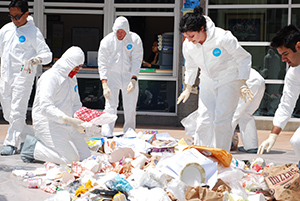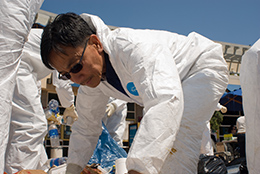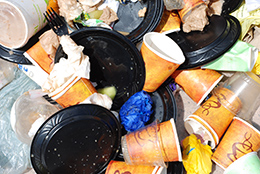Campus Surpasses Recycling Goal for 2008
Jim Gogek | January 12, 2009

Students sort trash during Earth Week, hunting for recyclable items.
Smashing through the recycling goal set for 2008, UC San Diego prevented 67 percent of its trash, construction debris and other solid waste from going into landfills last year. The goal set by the UC Office of the President for all campuses was 50 percent.
One of the greenest universities in America, UCSD is well on its way to achieving upcoming targets of 75 percent by 2012 and 100 percent by 2020, although the final goal will require a much greater commitment to recycling by the entire campus community.
“We’re very proud of breaking through to 67 percent,” said Maggie Souder, the campus Sustainability Coordinator. “It shows how serious our students, faculty and staff are about sustainability solutions. To get to the point where we’re sending zero waste to landfills in 11 years, though, every person on campus will have to help. We can provide the tools and knowledge, but we’ll need a total recycling mindset throughout the university.”

Alonso Noble during the 2008 Earth Week trash sorting event.
UC San Diego’s recycling guru is Alonso Noble, an assistant superintendent for Landscape Services and Refuse and Recycling in Facilities Management. He said that a very aggressive recycling effort for construction and demolition debris pushed UC San Diego way past the 50 percent mark for the approximately 19,000 tons of solid waste that the campus generates.
“At three major construction projects — Price Center expansion, Prebys Music Center and North Campus Housing — we achieved about an 80 percent diversion rate through working with our construction partners,” Noble said. “Those are very big numbers.”
Contractors are required to recycle construction and demolition debris, and to keep track of how much they divert. Asphalt and concrete are ground up and reused as aggregate material, scrap wood becomes mulch and metal is taken to recycling centers.
As high as UC San Diego’s diversion rate was last year, UC Davis did just a little better at 69 percent. All other campuses were lower and some did not achieve the 50 percent goal.

Trash from Housing and Dining during the 2007 Earth Week trash sorting event.
One of the most active contributors to UC San Diego’s success is Housing, Dining and Hospitality, which places single-stream recycling bins in all its housing units and recycles everything from old refrigerators to cooking oil. HDH’s Major Planet website is a great source for how members of the campus community can step up their recycling efforts.
Recycling is just one aspect of environmental sustainability at UC San Diego. What makes the campus unique is the collaboration among faculty, staff and students in research and action to solve environmental problems. From the birth of modern climate change science to one of the largest and most aggressive renewable energy programs on a university campus, UCSD is a living laboratory for climate change solutions. With approximately 200 courses, 83 student organizations and many student research opportunities related to environmental sustainability, UC San Diego students are deeply involved in finding solutions to local, national and global environmental threats.
See student video on UC San Diego’s commitment to climate solutions.

|